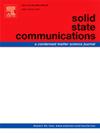Diisopropylammonium-halide (dipaHal) ferroelectric molecular crystals: Prospects, developments and controversies
IF 2.1
4区 物理与天体物理
Q3 PHYSICS, CONDENSED MATTER
引用次数: 0
Abstract
Over the past few years, there has been a notable surge in research interest directed towards organic molecular ferroelectrics. Consequently, it is now a critical juncture to delve into the fundamental structural constraints of molecular ferroelectrics, exploring various structural parameters, thermal characteristics, and distinct dielectric properties. This review paper embarks on a comprehensive examination of organic ferroelectrics, centering its focus on diisopropylammonium halides as a representative example. Within these pages, we provide an in-depth analysis of recent advancements in the field, encompassing their ferroelectric and dielectric properties, phase transition temperatures, and the phenomenon of spontaneous polarization. These insights open up new avenues for practical applications of organic ferroelectrics in diverse domains. However, it's worth noting that within this review, we also tackle a contentious issue that arises with diisopropylammonium iodide. This controversy revolves around the determination of the actual value of polarization, a topic that is thoroughly examined and discussed.
二异丙基卤化铵(dipaHal)铁电分子晶体:前景、发展与争议
在过去的几年中,对有机铁电分子的研究兴趣显著增加。因此,深入研究分子铁电体的基本结构约束,探索各种结构参数、热特性和不同的介电性能是一个关键时刻。本文以二异丙基卤化铵为代表,对有机铁电体进行了全面的研究。在这些页面中,我们对该领域的最新进展进行了深入分析,包括它们的铁电性和介电性,相变温度和自发极化现象。这些见解为有机铁电体在不同领域的实际应用开辟了新的途径。然而,值得注意的是,在这次审查中,我们也解决了一个有争议的问题,即二异丙基碘化铵。这场争论围绕着极化的实际价值的确定,这是一个经过彻底研究和讨论的话题。
本文章由计算机程序翻译,如有差异,请以英文原文为准。
求助全文
约1分钟内获得全文
求助全文
来源期刊

Solid State Communications
物理-物理:凝聚态物理
CiteScore
3.40
自引率
4.80%
发文量
287
审稿时长
51 days
期刊介绍:
Solid State Communications is an international medium for the publication of short communications and original research articles on significant developments in condensed matter science, giving scientists immediate access to important, recently completed work. The journal publishes original experimental and theoretical research on the physical and chemical properties of solids and other condensed systems and also on their preparation. The submission of manuscripts reporting research on the basic physics of materials science and devices, as well as of state-of-the-art microstructures and nanostructures, is encouraged.
A coherent quantitative treatment emphasizing new physics is expected rather than a simple accumulation of experimental data. Consistent with these aims, the short communications should be kept concise and short, usually not longer than six printed pages. The number of figures and tables should also be kept to a minimum. Solid State Communications now also welcomes original research articles without length restrictions.
The Fast-Track section of Solid State Communications is the venue for very rapid publication of short communications on significant developments in condensed matter science. The goal is to offer the broad condensed matter community quick and immediate access to publish recently completed papers in research areas that are rapidly evolving and in which there are developments with great potential impact.
 求助内容:
求助内容: 应助结果提醒方式:
应助结果提醒方式:


